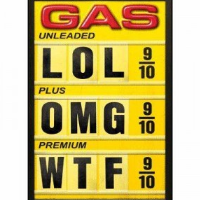Gas Prices up a Buck; Oil Refiners’ Gross Profits Double

There is no end to the list of reasons why Californians pay in excess of a $1 a gallon more for gasoline than the rest of the country and watch prices rise even as the worldwide price of crude oil drops.
An Exxon/Mobil refinery in Torrance has been down since a February fire and a second refinery in Carson is offline while undergoing regular maintenance. The state uses an eco-friendly gas mixture that requires seasonal refinery switchovers. Regulators are a pain in California. Taxes are high. The market is isolated from the rest of the nation. Californians drive a lot. It’s complicated.
The Los Angeles Times wrote about one potential reason this week that rarely makes it into the discussion, but might merit a place of honor. Greed.
Gross profits of oil refineries in California have nearly doubled in 2015, according to data crunched by Consumer Watchdog.
The California Energy Commission (CEC) keeps track of this sort of thing and according to them, refiners averaged gross profits of 49.3 cents per gallon from 1999-2014. So far this year, the average is 88.8 cents. The commission calculated that on July 6, when retail prices averaged $3.432, the refiner’s take was $1.166.
Gross profits, also known as refiner margin, are not easy to calculate because refiners do not provide information to the state about their costs or earnings. So the commission essentially subtracts the market price for crude oil from the wholesale price of gasoline. It is not a net income number, but is a valuable measure of the fluctuation in profit margins.
California pump prices averaged $3.878 a gallon as of Tuesday, according to GasBuddy.com, $1.126 more than the national average. But bargain hunters at Sam’s Club in Roseville could get away paying $2.92. Unfortunate folks who filled up at the Chevron at North Alameda Street and North Main in downtown Los Angeles paid $5.49.
Regular gasoline prices rose from $2.671 on January 5 to $3.897 on July 20 and jumped 45 cents between July 13 and now.
Tupper Hull, spokesman for the Western States Petroleum Association, explained the conventional wisdom that holds policymakers in thrall and probably guarantees the continued gasoline spike hikes. “The function of supply and demand work very efficiently to make sure that there's fuel at that pump,” he told the Times.
And, afterall, what else matters?
–Ken Broder
To Learn More:
California Oil Refineries' Gross Profits Nearly Double in 2015 (by Ivan Penn and Samantha Masunaga, Los Angeles Times)
California Drivers Pay Dearly for Refinery Problems (by John Kemp, Reuters)
Gasoline Prices Surge in California, Retreat in Rest of the Country (by Ken Broder, AllGov California)
Refining Profits: How Californians Get Fleeced at the Pump (by Jamie Court, Cody Rosenfield and Liza Tucker, Consumer Watchdog) (pdf)
- Top Stories
- Controversies
- Where is the Money Going?
- California and the Nation
- Appointments and Resignations
- Unusual News
- Latest News
- California Forbids U.S. Immigration Agents from Pretending to be Police
- California Lawmakers Urged to Strip “Self-Dealing” Tax Board of Its Duties
- Big Oil’s Grip on California
- Santa Cruz Police See Homeland Security Betrayal in Use of Gang Roundup as Cover for Immigration Raid
- Oil Companies Face Deadline to Stop Polluting California Groundwater





